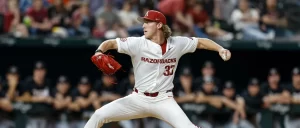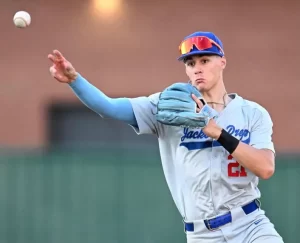White Sox 2018 Draft Cheat Sheet
As we now sit less than a month out, the MLB draft is finally starting to take shape. You’ll see more and more mock drafts coming from the major publications as the intentions, preferences and appearances of the executives and top scouts become more and more evident. However, as typical in the MLB draft, projecting the draft from a month or even a week out is a daunting task yielding little success from even the most respected, plugged-in journalists and evaluators. That has been even truer in recent years as last year we did not know the first pick until hours before the draft when the Twins struck a surprise deal with prep shortstop Royce Lewis.
Looking at this class as a whole, it really hasn’t developed in a way that has draftniks exuding excitement. As we hear all too often with underwhelming draft classes – this draft’s strength is depth. Looking specifically at the White Sox – picking fourth overall – the top-heavy slotting system provides them with an opportunity to get creative and take advantage of the pool system if they wish.
I am sure many are familiar with the strategy involving a team drafting a first rounder with the intention or even antecedent, unofficial agreement that the player will be signed under slot – allowing the team to reallocate the excess to a later pick. The specifics of the White Sox pool, picks and the general draft rules have been put together nicely by our James Fox.
This strategy was popularized with the Astros’ success story of surprisingly taking Carlos Correa under-slot #1 overall and then following up with an over-slot Lance McCullers, considered a top 20 talent in that draft, in the supplemental round. More recently, Philadelphia serves as the cautionary tale (at least for now), as they took the light-hitting Mickey Moniak 1st overall in 2016 to push back some funds to bring in SoCal prep fire-baller Kevin Gowdy who hasn’t been able to stay on the mound since going pro. Regardless, the White Sox and other teams in the top ten will certainly be looking to employ this strategy even if to a lesser extent than the aforementioned examples. This isn’t to say the White Sox would pass on the “best player available” to save money, rather, with the current stock of this draft class, the White Sox might be able to take their preferred player and still save money at the same time.
While I may be overemphasizing the likelihood of an under-slot signing, the idea is rooted in the simple fact that the talent at the top of the first round, outside of maybe only Auburn’s Casey Mize, is lacking players with the right combination of track record, high-upside profile and health. Every player after Mize seemingly has some sort of wart that that suppresses their value and eventual signing bonus. With that in mind, this is a draft where there may not be much of a difference in the player taken say, 6th overall, compared to the player taken 17th overall. This has the feel of a draft where the results would change dramatically based on the slotting of the teams, and who the “best player available” is will be dependent on which team is sending Commissioner Rob Manfred to the podium. Of course that’s a blanket statement applicable to any year, but this year has less consensus forming throughout the industry than we’ve seen in years’ past.

So bringing it back to a White Sox lens, it is rare that the national writers have a good feel for the White Sox intentions coming into the draft. From a projection standpoint, the Sox have a “luxury” of sorts in the fact that they can just sit back as the three teams picking before them will decide Chicago’s fate. The team can pick their four favorite scenarios and just wait it out. According to the media, “college” is the consensus feeling. Keith Law of ESPN says he has been, “…hearing them mostly associated with picking college players.” Similar to Law, Jonathan Mayo of MLB.com expects more of the same from the Sox: “Chicago has gone the college route with its first pick in each of the six previous seasons and there’s no reason to think it’ll deviate from that philosophy.” Kiley McDaniel of Fangraphs isn’t deviating from the industry view either: “The White Sox are also on all three of the top college bats (Bohm, Madrigal, Swaggerty), and it sounds like they’ll take the one who gets to them here.” So as you can see, there is a trend forming. I am sure part of it is based on sourcing and gauging those in the industry, though I am also sure some of it is writers banking on the White Sox’s draft history – a draft history that is as consistent as any team in the league.
As to which college player the Sox might look to grab, there is far from a consensus there. It really seems as if the White Sox are the one team in the top 5 that the industry doesn’t have any semblance of a feel on when it comes to naming specific players. So for this article, the intention is to catch up those who haven’t been following the draft process thus far and help familiarize them with the names that are important to the White Sox or really, the top talent in the draft. I will break down the players by the different pedigree and speak to the general sentiment from the industry.
I should say that moving forward – and take it with a grain of salt – it is my expectation that the White Sox will have reports tying them a different prospect every week or so. Players like Madrigal, Singer, Bart and others make sense as the guys who will go around the fourth pick but are not necessarily the White Sox “guy.” While insignificant in the grand scheme of things, I would imagine some sort of coordinated “leaks” that muddy the water of their true focus and intention. As I’ve thrown out there already, cutting deals with players is especially important so teams will be looking to shield their hand and even deceive agents as the draft process winds down.
In any case, let’s look at every group of prospects. Going from least likely to most likely, here are the notable prospects of each group.
4.) High School Arms
Starting with the prep arms, the White Sox haven’t taken a high school pitcher in the first round since they took hometown kid Kris Honel out of Providence in 2001. Aside from taking a high school catcher, a high school arm is considered the riskiest pick in the draft. The White Sox, who are particularly risk averse in their draft strategy, are unlikely to use their 4th overall pick on a prep arm. However, there is plenty of talent here with some and it’s not unheard of that a top prep arm that falls in say, the top 20 draft prospects, could fall to the later rounds in the draft and sign over slot – this is how the Cubs were able to nab now White Sox prospect Dylan Cease in 2014. Given the output of young talent we have seen this past half decade, people don’t really seem to blown away by the prospect of a 17-year-old hitting 96-97 MPH anymore so there could be a value in this player group later on in the draft for a scouting direction in which Nick Hostetler wants the team to take more prep players.
Sticking with the top of the draft though, Matthew Liberatore is maybe the highest-rated prospect from the group and he’s certainly my favorite prep arm. The lanky lefty attacks his opponents by moving quickly and throwing three pitches for strikes while showing an in-your-face type of craftiness. Liberatore quick pitches, routinely changes his tempo and has great baseball instincts. He does all of this seamlessly as he has had no issues repeating his motion. He’s an 18-year-old who with a good frame, a southpaw attack and he excels in areas that typically require years of experience. The knock on him is up-and-down velocity and losing some ticks later in the game, which isn’t atypical for a guy who just went to his senior prom.
Elsewhere among prep arms, Carter Stewart, a 6’6” Florida hurler, has been moving up the boards with incredible spin rates on his breaking ball and a fastball that sits in the mid 90’s. Ethan Hankins, who sported video game stuff for USA’s 18U team this past summer, was one of the best prospects coming into his senior year but an early season elbow scare and a thin frame have dulled some of his luster.
3.) High School Bats
Arizona prep third baseman Nolan Gorman had been the top prep coming into the class. With serious power that some project a 7 grade on and a strong rep in the showcase circuit, Gorman has gotten the attention of opposing coaches. Gorman’s reputation might have belied him as he isn’t seeing many pitches to hit at the high school level. More recently, the big grade on his power has been somewhat overshadowed by new concerns about kinks in his swing and whether he can stick at 3B. Nonetheless, he’s a very talented prospect and a guy that each team may evaluate very differently.
Outfielder Jarred Kelenic out of Kenosha may have superseded Gorman as the top prep bat – at least for now. Playing in the Midwest has put Kelenic on a different timeline but now moving to the homestretch of the draft process, Kelenic has really shown up when it’s important as I am told he looked outstanding out in Iowa playing in the Perfect Game Spring League. He’s a high motor guy with no glaring holes in his game and he has shown more power this spring than he has in the past. If the White Sox surprise with their pick, this would be my bet.
2.) College Arms
Usually the popular pick for the White Sox, this appears to be an underwhelming class of arms. Casey Mize is far and away the best prospect. With incredible peripherals in the NCAA’s top conference there is no doubt that Mize should move swiftly through the minors and be a major league starter sooner than later.
Past Mize, Brady Singer is arguably the most highly regarded. Looked at as the clear top prospect of the class this time last year, Singer seems to have suffered from some prospect fatigue and certainly pitches in a way that creates concerns about his arm action. Whatever it may be, the stock decline isn’t due to performance as Singer has improved his numbers both peripherally and in run prevention. Singer is a ferocious competitor who the White Sox have no shortage of looks at and the Sox do have a reputation of being less concerned with pitchers who have less than ideal arm actions. If the Sox go with an arm, Singer’s odds would have to be as a good as any.
Out of the University of Southern Florida comes LHP Shane McClanahan. The flamethrower has been relatively overlooked in the draft process. McClanahan strikes out an awful lot of hitters but has also walked more than you would like to see. The 21-year-old has already had Tommy John as a freshman and has a finish that lacks trunk flexion and would likely scare those who follow pitching mechanics in a religious manner. But as a hard-throwing lefty out of a Florida college, the easy and often-used comparison is Chris Sale. While they are much different pitchers in looks, you do have to see the same high-upside, high-risk attributes that were also true of the former South Sider.
1.) College Bats
Leading the most likely pedigree group for the White Sox, it seems 2B Nick Madrigal out of Oregon State is the most highly regarded guy though that’s entirely arguable. Madrigal has played SS at OSU in the past but has since moved to 2B as his teammate and fellow MLB draft hopeful, Cayden Grenier, is a plus glove at the 6. Madrigal had a wrist injury sideline him earlier in the season but when healthy, he has been very productive. Nick possesses a bunch of tools and a great makeup but is listed at only 5’7”. He’d be a polarizing pick as he checks most boxes but is still a small guy who lacks power. In a world where 5’6″ Jose Altuve is the best player on the reigning Champs and 5’9″ Mookie Betts is the best player on the pennant-leading Red Sox, there should be a good chunk of support for Madrigal. Even so, his size and lack of power really limits his margin for error once he is drafted.
The next player who finds himself all over mock boards is Wichita State’s 3B Alec Bohm. Bohm has maybe the biggest upside of all the college bats but needs to stay at third to make good on that potential. Drawing comparisons to Kris Bryant due to his figure, Bohm isn’t quite as advanced at the plate or as athletic as the former NL MVP. Evaluators are very split on whether Bohm can stick at the hot corner. There is a slew of opinions on his athleticism and being 6’5″, he carries the general cautionary warning about outgrowing third base. Another check for Bohm is he fits the recent White Sox draft trend with an obscene K/BB of .67. In any case, if Bohm is the “best player available” for the Sox, he could also be a candidate to be an under-slot pick. As a player repped by the Wasserman agency, there is a good chance that Bohm enters draft night with a deal in place.
A guy forcing his name into the top 5 conversation more recently is Georgia Tech catcher Joey Bart. Bart is different from a lot of catching prospects in that he is widely touted as a guy who is going to stick behind the plate. He has the arm, receiving skills and footwork to quell the usual concerns of whether someone could stay at the position long term. Past that, the concern is whether Bart has the hit tool and discipline – the power is seems to be there. Bart has made big strides this year in both his plate discipline and in the swing-and-miss in his game which has propelled him up to the top of the mock draft boards. There is such a shortage of catching around the league that every team should consider a guy like Bart. That said, the White Sox would have to look deep in the mirror to pull the trigger on this one.
Travis Swaggerty, a left-handed hitting outfielder out of the University of South Alabama, projects as a quasi-five-tool player that would profile nicely at the top of the order. However, playing in a conference that should be dominated by a top first round talent, Swaggerty has concerned some with his sub-.300 average and hot-and-cold struggles throughout this spring. Swaggerty has had a lot of smoke around the White Sox, more so earlier in the process, but it seems more like guesswork than it was related to any inside intel. Frankly, I’d have a tough time making sense of Swaggerty as a White Sox pick.
Lastly and tied to the Sox least-ly is Florida’s SS/3B Jonathon India. He would likely be another option for an underslot pick at #4. After getting in better shape, India has had possibly the most impressive offensive campaign in the SEC. He would seem to be a reach of sorts but as a bat making strides and showing some defensive ability he could be one of the safer plays as a well-rounded performer out of a marquee program. Whether India is a SS or 3B at the next level is unclear. How a team feels about his spot on the diamond will likely have a big impact on the way they value him.
Moving forward, our FutureSox draft coverage will continue in the next three weeks with our profiles of the relevant prospects. I will have another piece coming out shortly pertaining to draft philosophy. As always, you can sign up to our email list in the box below.
Want to know right away when we publish a new article? Type your email address in the box on the right-side bar (or at the bottom, if on a mobile device) and click the “create subscription” button. Our list is completely spam free, and you can opt out at any time.







